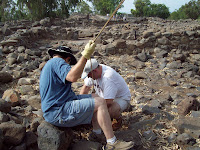Good morning. As promised, I want to tell you about some of the lectures that we have been having. Monday through Thursday, from 8:00 p.m. to 9:00 p.m., we hear lectures on topics that help us to understand the work of the archaeologist. One of the best things is that the lecturers assume you know very little (which is true), and then work from there.
Dr. Elizabeth McNamer Dr. James Strange
The first lectures were delivered by Dr. Elizabeth McNamer, professor at Rocky Mountain College and Dr. Aaron Gale (not pictured), Associate Professor and Co-ordiantor of Religious Studies at West Virginia University. Monday and Tuesdays presentations focussed on an introduction to the development of the Old Testament, Hebrew people and the growth of Israel. The sessions included:
Key Old Testament Events and suggested time frames:
Moses 1200 BCE
Joshua entering promised land 1160 BCE
Joshua entering promised land 1160 BCE
Development of Kingship 1000 BCE
Israel destroyed by Assyrians 733 BCE
Entrance of Babylonians 586 BCE
(Now called Jews)
(Now called Jews)
Entrance of Herod the Great 37-4 BCE
Destruction of the Temple 70 CE
Bar Kokhba rebellion 135 CE
Each of these events and others brings with it its own history and role in the development of the Hebrew people.
Dr. Carl Savage, Professor at Drew University and Associate Director of the Doctor of Ministry Program in Madison, New Jersey was also one of our facilitators. Giving a thought provoking lecture, Dr. Savage targeted Roman and Hellenistic material culture. We received background on the 1st century BCE to 1st century CE, the leadership and the heritage including information on the Ptolemies, Seleucids and Hasmoneans. His approach helped to connect all of this to Bethsaida. He reminded us of a few of the indicators of a Jewish presence:
Appearance of limestone vessels (16 found in Bethsaida)
Method of burial.
No escape tunnels
Another lecture wasn presented by Shai and Judith Schwartz about the development of the Kibbutz. This was interesting since volunteers for Bethsaida are staying at the Ginosar Kibbutz Inn. They explained that the kibbutz was set up to be an independent living community with much being held in common. They were primarily agricultural with a strong Jewish work ethic.
Shai and Judith explained that there were no paychecks like we see today but everyone worked on the Kibbutz and all had what they needed. A kibbutz such as Ginosar now has tourism as part of their income but grow almost everything that is needed such as fruit and vegetables. Shai and Judith have been with us at the dig site constantly and have been a great support! Judith is a correspondent for KPTM Fox New in Omaha, Nebraska and has spread the word about Bethsaida. Shai, a retired engineer has been a valuable asset in plotting areas at the did site.
Dr. James Strange, Professor at the Universtiy of South Florida and known for his excavation of Sepphoris, lectured on the Archaeology of Galilee. Volunteers hear him explain how archaeologist had to develop interpretive techniques to be effective at archaeology: what can be infered from the religion of the time and the social structure. He added that there must be a context in which we can understand the ancient world and much, much more! Dr. Strange noted that there are 24 major sites (such as Bethsaida) with sustained archaeology. Intriguing!
What a perfect way to end the day!
Safe Travel!
Gloria

































